As an artist, James Croak’s preferred medium—dirt combined with a material that allows it to be sculpted and hardened—is not at all what you’d call typical.
But then again, neither is Croak, a figurative sculptor who came of age at a time when figurative work of any kind was not a respected form of artistic expression.
“I was in the last crowd almost to the year that was taught abstract is king,” he said in a recent interview. “Two years later, they were moving into figuration. But when I was in school they came up with exercise after exercise to get us to think of art as something other than a figure.”
“I went into school wanting to be a figurative sculptor and they beat that out of us,” he added. “After school, it took 10 years to get back into what I want to do.”
Croak points to that motivation as the primary reason he and fellow artist Jeff Koons became friends. At the time both artists believed, beyond the realm of all logic and evidence, that figurative sculpture was the future of art.
“I can’t say how ridiculous that sounded based on the conceptual art coming out then,” the artist said. “Figurative sculpture was stupid beyond stupidity.”
But still, he stuck by it and his own personal sculptural revolution began with the use of figures that already existed—mannequins, dolls and other sorts of pre-fabricated objects.
“I didn’t have the ability to make anything, because I went to art school,” Croak noted wryly. “They once asked Pete Seeger if he read music. He said, ‘Not enough to hurt my playing.’”
Along the way, the artist’s foray into figurative sculpting also led him to taxidermy, which has figured prominently in his work over the years. For his 1982 sculpture “Pegasus,” he created a full-size horse with wings breaking through the roof of a souped-up car. It garnered a great deal of attention when it hit the scene.
“I was in Southern California at the time, which had a history of hot rods and low rider culture, so I did a piece in that mode,” he explained. “It was a pop hit and the art crowd liked it, too.”
It was Croak’s collaboration with taxidermists that eventually led him to develop a similar process with dirt when he moved to New York.
“They used sawdust and resin, almost like clay, to attach the hoof in taxidermy,” he said. “I wanted to cast a figure and I thought I’d make it out of sawdust, but I couldn't find enough sawdust.”
“But in Brooklyn the place next door had been excavated and there were just piles of dirt,” he said. “I wondered if that would work. It mixed it with glue and made something: vertical dirt. No one had tried this for figuration before. I was the first one.”
.
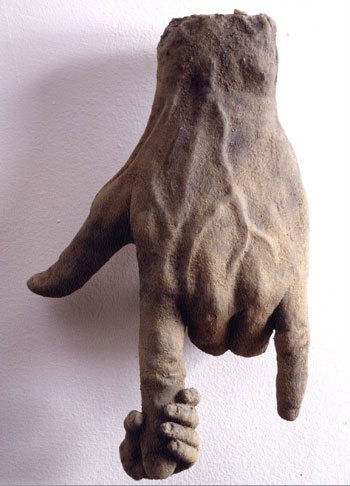
"Hand Series #3" by James Croak, 1998. Cast dirt, 12 x 7 x 3 inches, edition of 12.
.
These days, students from around the world write to Croak asking him how to make his dirt compound. He freely shares the information, curious as to what other artists might be able to do with it.
What he decided to do with dirt was make life-size sculptures; a number of dirt men now populate the backyard of his home set in the woods near Sag Harbor. One stands near the figure of a wolf and two others stand back to back, while another well-dressed figure in a trench coat holds a shovel he appears ready to use.
.

"Dirt Man With Wolf" by James Croak. Cast Dirt. Photo by Annette Hinkle.
.
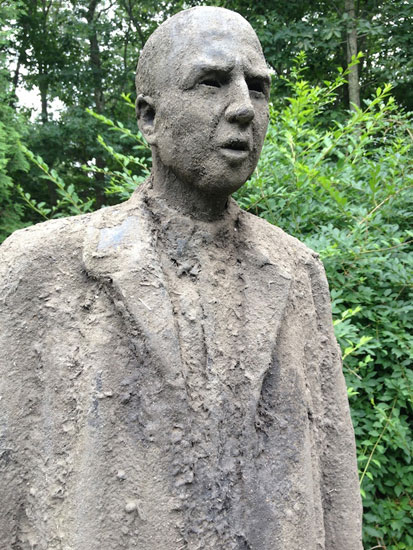
Detail of "Dirt Man With Wolf" by James Croak. Cast dirt. Photo by Annette Hinkle.
.
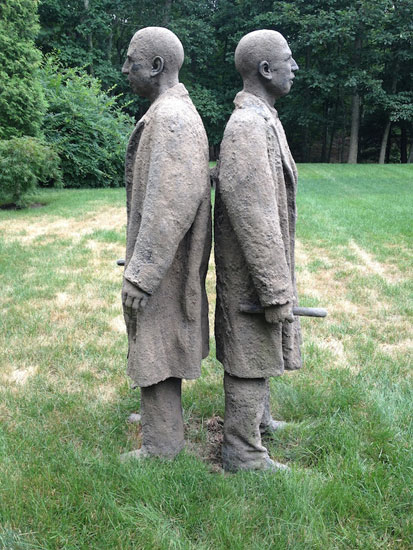
"Double Dirt Man" by James Croak. Cast dirt. Photo by Annette Hinkle.
.
Croak notes that while most of the faces of his dirt men are self-portraits, he also uses the visage of the late actor Brion James in his work.
“He played the first robot in ‘Blade Runner,’” Croak said. “That was the image I used. I downloaded pictures of him and sculpted his head and put it on the figures.”
But why?
“I like that hapless urban lostness he portrayed,” Croak said. He went on to reference T.S. Eliot’s poem, “The Hollow Men,” which includes the image of a “headpiece full of straw.”
“Sculpture should be something to think about as well as understand. It should have visual pleasure, some sort of idea, it should be something unusual,” he said, pointing to “Dirt Man With Shovel” as an example. “The only two times you see a man in a coat and tie with a shovel is a funeral or a groundbreaking—a beginning or an end. It implies opposite emotions. It’s like he’s searching for something, he is that something. He’s dirt, the whole dust to dust imagery. He is what he’s looking for.”
.
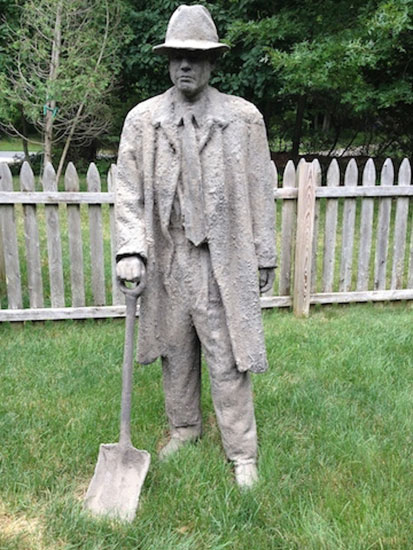
"Dirt Man With Shovel" by James Croak. Cast dirt. Photo by Annette Hinkle.
.

Detail of "Dirt Man With Shovel" by James Croak. Cast dirt. Photo by Annette Hinkle.
.
“A good artwork will have different identities,” he added.“Unless you’re doing cynicism or skepticism.”
.

James Croak with "Dirt Man With Shovel." Cast dirt. Photo by Annette Hinkle.
.
Like his artwork, Croak, too, has several identities. Though best known for his striking figurative sculptures, Croak, who has a master’s degree in philosophy, is also an accomplished writer, and three books that have been or were set to be published in 2014 contain the artist’s artwork and his writing.
The first is “Mapping It Out: An Alternative Atlas of Contemporary Cartographies” (Thames & Hudson; June 2014). Edited by Hans Ulrich Obrist, the book was inspired by London’s Serpentine Gallery 2010 Map Marathon and a long collaboration with John Brockman and the Edge Foundation (which invites sophisticated minds to ponder some of life’s most probing questions).
In “Mapping it Out,” Croak is one of 130 architects, writers, designers, mathematicians, scientists and artists (including Yoko Ono, Damien Hirst, and Ed Ruscha) whom Obrist invited to create a personal map depicting a real world or imagined terrain—be it physical, political, internal or ethereal.
Croak’s offering is an image that examines the power of the vote in the United States relative to population. In it, he skews a map of the U.S. to illustrate the impact of each person’s vote based on two senators per state. This system, he notes, allows less-populated states to exert undue influence on American politics. In his map, highly populated New York, California and Texas are reduced to shriveled grapes while Wyoming appears to be the largest state in the union.
“The more populous the state, the less significant is your vote,” he says. “Everything is skewed.”
Croak’s second book-based image this year will appear in Imogene Racz’s “Art and the Home: Comfort, Alienation and the Everyday” (I.B. Tauris). The book, which Croak expects to be published by the end of the year, delves into the notion of home and the many roles it plays in our lives—from comforting to threatening—and includes artwork, primarily sculpture, and ideas by a range of artists who explore the idea of dwelling space and domesticity.
Croak’s piece in the book is one of his dirt window sculptures, which play on Marcel Duchamp’s sculptural piece, “Fresh Widow.”
.
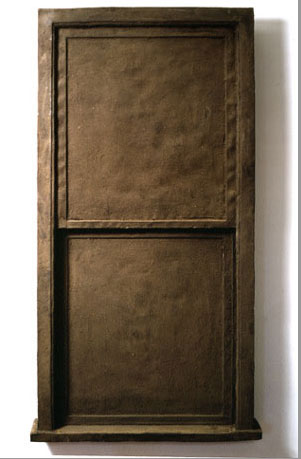
"Window Series #1" by James Croak, 1991. Cast dirt, 70 x 35 x 7 inches.
.
“It’s a window sculpture in the Museum of Modern Art where the glass is backed with black leather,” Croak said, describing Duchamp’s piece. “It’s an analogy between painting and all the widows who were walking around after World War I.”
“I redid it as ‘Soiled Widow,’” he noted. “It keeps the pun going and is now something fertile and effervescent and not dead.”
The third book with a contribution from Croak was published in Korean by Woongjin Knowledge House in Seoul in August, and the first U.S. copies should arrive this month. “The Guru Challenge” by Douglas Huh asked 93 participants to pose one question that could change readers’ lives.
.

“The Guru Challenge” by Douglas Huh. Featuring a contribution by James Croak.
.
Croak’s essay for the book asks, “Why do we prefer the familiar?” From the mates we choose to the routes and routines we fall into, Croak argues that humans are naturally repetitive creatures who seek out the familiar again and again. In his piece, he invites readers to discover themselves by shaking it up and doing the unexpected.
“Park your car backwards and see how it feels,” he writes. “Stir your coffee the opposite way. Reach for everything with your opposite hand. Climb stairs starting with the different foot. Wear a color you think is ugly. Order a dish never tried and examine your response. Part your hair on the opposite side. Flirt with someone out of your league. Vary the miniscule in your life until the familiar becomes strange.”
For his part, Croak practices what he preaches and seems willing to mix it up artistically by taking creative chances. Among his most recent artistic efforts is a series of desert photographs taken at night in the Tanque Verde area near Tucson, Arizona.
.

"Nogales" by James Croak, 2013. Duotone print.
.
“It’s beautiful,” he said. “When you go out there at night it’s another planet. It’s a struggle for life to survive, everything out there is fighting the elements.”
And it’s awake. Among the critters that appear when the sun goes down are snakes, spiders, rabbits and bobcats.
“At night, everything comes out,” he said. “I get kind of scared out there by myself. My sole weapon is this two million candlepower flashlight. I think if anything gets near me, I’ll blind it.”
.

"Grand Canyon, 3 a.m." by James Croak, 2005. Cyanotype print.
.
Croak has titled his photographic series “The Other 12 Hours” and all the imagery offers a view of the world that is typically unexplored.
“You see the night sky quite a bit in these pictures,” Croak said, acknowledging that he discovered his shooting method quite by accident.
.

"Cactus Desert" by James Croak, 2013. Cyanotype print.
.
“I was using flashes at night in the desert, which hadn’t really been done, to see what the images were,” he said. “One time the flash didn't go off and I had a really nice composition.”
“That photograph informed what I’m doing now, which is long exposure time lapse photographs up 30 seconds,” he said. “It’s the time of the day that’s not documented by photography, and when I was out there, tarantulas were following me around.”
.

"Coronado" by James Croak, 2006. Cyanotype print.
.
And though he has spent the last decade devising and perfecting his photographic technique, Croak feels he’s still just getting his feet wet with the medium.
But in the midst of a world that he sees as more and more cynical, he’s pretty sure he’s on to something.
“It’s hard to imagine anyone being a cynic or skeptic when they see the night sky,” the artist said.
“Cynicism could be a feature of not seeing the sky,” he mused. “Marcus Aurelius’s first principles.”
.
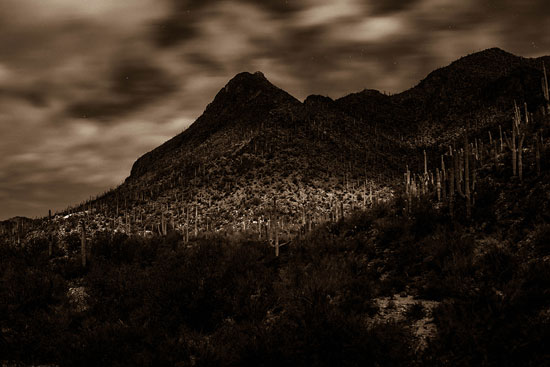
"Tucson" by James Croak, 2013. Sepia print.
.
Other Projects
Beyond his recent inclusion in these three books, Croak and his work have been showing up, or will be showing up, in a number of other projects.
His sculpture, “Dirt Baby,” will be included in the “Disturbing Innocence” group exhibition curated by Eric Fischl and running from October 25, 2014 through January 31, 2015 at the FLAG Art Foundation at 545 West 25th Street in New York.
According to the Foundation, “Disturbing Innocence” will feature more than 50 “historical and contemporary artists whose use of dolls, toys, mannequins, robots, and other surrogates forms a deep and powerfully expressive genre.” An opening reception is scheduled on October 25 from 6 to 8 p.m. www.flagartfoundation.org.
He is featured in a documentary, “Young Turks,” directed by Stephen Seemayer and shot between 1977 and 1981 that was re-cut and re-released in 2013.
According to the description of the film on IMDb.com, Seemayer’s documentary is “a Super-8mm movie of his creative friends in their unnatural habitat: the deserted industrial and commercial buildings of Downtown Los Angeles. His camera captured them at work and at play, discussing art and what it meant to share the mean streets with those less fortunate. A rough cut of 'Young Turks' was screened in 1981 and never seen again. Newly digitized and fully reedited with additional footage, the film is a remarkable document of L.A.'s urban core at a crossroads.” http://www.imdb.com/title/tt2417554/
The artist had four to eight pieces of his sculpture, including “Dirt Man with Shovel,” on view at different times during the "Collection of Leeuwenhoeve" exhibition at the Osthaus Museum in Hagen, Germany. The exhibition ran from May 20 to August 3, 2014.
Croak’s work with dirt is also included in South African artist Ciara Struwig’s “Evidence Project,” in which she satirically subjects artist's studios to "crime scene" procedures.http://ciarastruwig.com/james-croak/
_______
EDITOR'S NOTE: James Croak is a staff writer for Hamptons Art Hub and contributes reviews and cultural commentary.
________________________________
Copyright 2014 Hamptons Art Hub LLC. All rights reserved.
